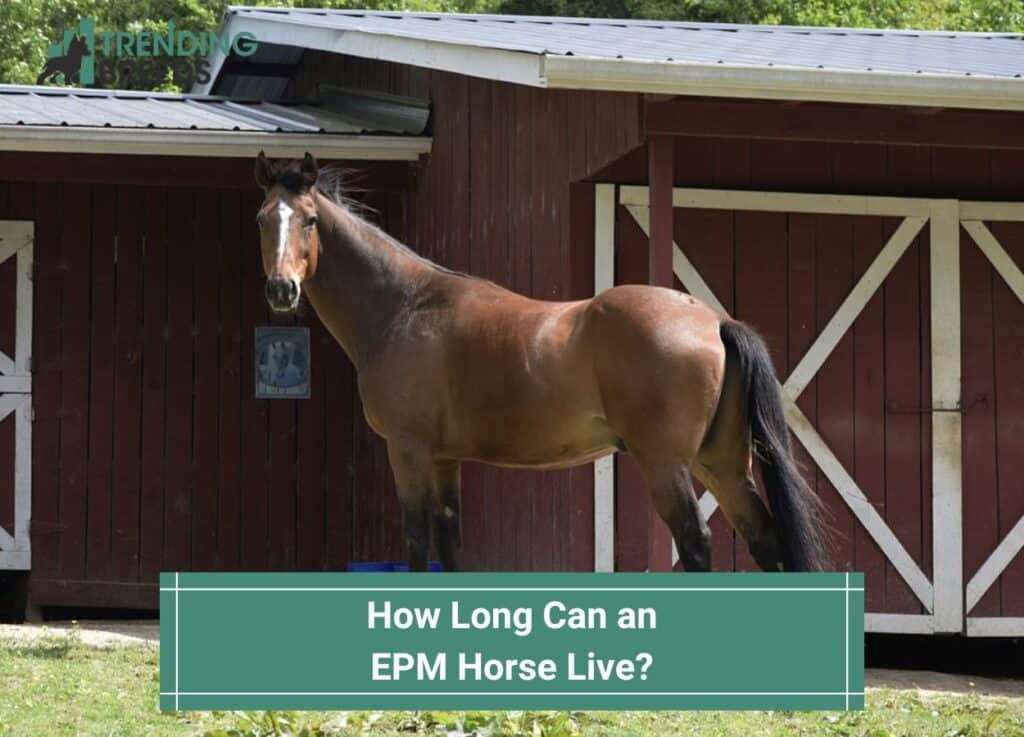
EPM is a deadly disease that affects more than half of the horses in the United States. This disease can be fatal. so it’s understandable why you, as a horse owner, may be wondering how long can an EPM horse live?
It’s difficult to say how long an EPM horse can live. Some horses may recover completely, whereas the disease may have turned terminal for others.
Some horses may live up to a year before passing away, whereas others won’t make it to the next month.
Keep reading below for more information.
Before you scroll further down this guide, check out these other horse-related articles: Can You Go Horse Riding While Pregnant? and How Many Acres Of Land Do You Need For Horses?.
Table of Contents
What is Equine Protozoal Myeloencephalitis (EPM)?

It’s not easy to spot Equine Protozoal Myeloencephalitis (EPM).
The symptoms of this fatal disease can range from mild to severe. They frequently resemble those of other health issues in horses, so diagnosis can be challenging.
The EPM-causing bacteria may have infected more than half of the horses in the United States.
The protozoan parasite Sarcocystis neurona is to blame. There is no equine-to-equine transmission of the disease.
Instead, the definitive host, the opossum, spreads the protozoa after picking them up from other animals like cats, raccoons, skunks, armadillos, and maybe even harbor seals and sea otters.
Sporocysts, the infectious stage of the organism, are excreted in the opossum’s poop. While grazing or consuming infected food or water, the horse comes into contact with infectious spores.
Once swallowed, Sporocysts travel from the digestive system to the bloodstream and the brain. There, they launch an assault on the horse’s brain and spinal cord. The condition can develop gradually or rapidly.
EPM can cause irreversible and permanent damage to the nervous system without proper diagnosis and treatment.
Although clusters of EPM cases have been documented, the disease typically strikes individually and affects only a single horse at a time.
No observable sex or seasonal differences have been found, and incidents occur in horses of all ages, although they are more common in young athletes.
Symptoms of EPM

The clinical manifestations of an S. neurona infection vary depending on the region of the central nervous system in which the parasite is located and the kind of harm it has done to that region.
The disease can develop gradually or rapidly. Affected brainstem areas can cause drowsiness, behavioral modifications, and cranial nerve paralysis (facial nerve paralysis, tongue paralysis, and difficulty swallowing).
While damage to the spinal cord can cause gait abnormalities, incoordination, ataxia (inability to control voluntary muscle movement), spasticity in each of the four limbs, and weakness of the muscles.
There is a possibility that the signs on either side of the horse will not be identical to one another (asymmetrical). It is common for horses to stand splayed-footed or lean against walls or other objects for support.
Some patients experience a period of improvement followed by a relapse a few days to a few weeks later.
The variables that determine whether or not a neurological disease will advance to a severe stage are poorly understood.
How Long Does a Horse With EPM Typically Live?

It is difficult and practically impossible to say with absolute certainty how long a horse can survive after being diagnosed with EPM.
Because individual horses may react differently to EPM treatment, estimating how long a given horse will live is difficult.
However, if this disease is caught early, a horse has a better chance of making a full recovery and living for a more extended period.
Therefore, as soon as you notice any signs that your horse may have EPM, you should get it checked out as quickly as possible and begin aggressive treatment as soon as possible to improve the horse’s chances of recovering fully.
Horses with EPM have a 15–25% chance of recovering fully. The majority of treated horses improve, according to the available data (about 60-70 percent).
However, the best outcomes are seen when treatment is started early on. Improvement is most noticeable over the first four weeks.
Even after therapy, about 80 percent of horses test positive for the disease when they get spinal taps. Ten percent to twenty percent of horses have relapsed within two years.
Factors Affecting EPM Horse Survival

Many horses lose their lives to EPM, a devastating neurological disease, although some affected horses fully recover. A horse’s prognosis with EPM can be estimated using the factors discussed below.
The Stage of Disease
A horse’s prognosis is heavily dependent on the diagnostic stage. The horse has a better chance of recovery from EPM if it is discovered at an earlier stage.
The Standard of Treatment

Horses have a better chance of surviving EPM if the disease is caught early and treated aggressively and with high-quality medication.
However, remember that individual horses have varying responses to treatment and that 10-20% of horses will relapse within two years. Just give it your all and pray for the best.
The Severity of Infection
If the disease has spread throughout your horse’s body, it’s probably fair to say that the horse has a slim chance of survival.
Therefore, the degree of infection is a crucial consideration in estimating a horse’s expected lifespan.
If the veterinarian says the disease is incurable, the horse has little hope of getting better. The horse might not make it through the next month.
Instead of worrying about how long their horse will live with EPM, conscientious horse owners plan euthanasia when the disease becomes terminal.
The only ethical and practical option is to end the horse’s suffering if it cannot eat, move around, or even stand. At least the horse’s owner will have peace of mind knowing that their companion is no longer suffering.
Can Horses Recover From EPM?

Depending on the situation’s specifics, the EPM attack may or may not be lethal.
There is a greater likelihood that the horse will not survive if the infection is particularly serious. The following variables will determine the degree of infection.
The severity of infection can be evaluated by estimating the number of organisms consumed by the horse.
Horses that consume greater quantities of contaminated grass or feed than others are at a far higher risk of developing a life-threatening infection.
Parasites may have multiplied and caused greater damage if the horse was not treated quickly enough.
The extent of an infection is also affected by the person’s stress levels. When an already vulnerable horse is infected with EPM, the results might be catastrophic.
The location of the damage might also affect how severe the infection is. An infected horse may have problems anywhere along the central nervous system.
Diagnosis of EPM in Horses

A correct diagnosis can be elusive because there is no diagnostic test for EPM, and its symptoms are similar to those of other neurological disorders.
First, your veterinarian will examine your horse thoroughly to determine its overall health and look for any warning signs. One telltale sign is that the disease typically affects only one side of the horse or one body area.
If your veterinarian has reason to suspect EPM, he or she may recommend testing of blood and CSF.
A specialized needle can be placed into the spinal canal or in a location on the lower back to collect cerebrospinal fluid. This can be done at either location.
You and your vet should talk about this process’s potential hazards beforehand.
A positive blood test for the parasite indicates that the horse has come into contact with the parasite; it does not indicate that the horse has or will develop clinical disease due to the infection.
Treatment should start immediately if a prompt and correct diagnosis has been made.
Treatment of EPM in Horses

The sooner the horse receives care, the higher its likelihood of recovering fully. When EPM is treated vigorously, the symptoms disappear in 60%-70% of patients.
Many horses can resume their regular routines. Here is what you need to know about EPM treatment:
- Several different drug combinations can be used to treat EPM, but the FDA has also approved several proprietary antiprotozoal medicines for use in the treatment of EPM. If you want specific advice and treatment choices, talk to your vet.
- Anti-inflammatory medicines may be administered to lessen the severity of symptoms and the likelihood of adverse responses caused by the parasites’ deaths.
- Antioxidant vitamin E supplementation is commonly suggested to speed the recovery of damaged nerve tissue.
- Despite their rarity, complications from treatments can impact horse fertility and present some risks to the health of foals.
- Even though the success rate is rather high, not all horses will benefit from treatment. Ten percent to twenty percent of horses may have another recurrence.
- It may be necessary to take blood samples from a treated horse periodically to check for adverse reactions, such as anemia, a low platelet count, or a low white blood cell count.
- Antifolate medications are utilized in the treatment of EPM. Therefore, checking for anemia at regular intervals during treatment is recommended.
Potential for Relapse

EPM relapses are a cause for concern. Relapse occurs in 10% of treated horses within 1-3 years after stopping therapy with any of the foregoing FDA-approved medications.
Poor drug penetration across the blood-brain barrier or a weakened immune system could be to blame for relapse, although these factors alone cannot explain the phenomenon.
Preventative Measures

According to the available literature, there are several measures horse owners can take to prevent the spread of EPM.
A vaccination is currently available to immunize horses against Sarcosystis neurona, yet its effectiveness is still uncertain.
Good horse-keeping techniques can at best reduce the risk of hay, feed, and bedding being tainted by animals like possums and rodents.
Here are some recommendations:
- Do not leave any feed rooms or containers open.
- Make use of feeders that restrict wild animals’ access and prevent waste.
- Remove any spilled grain promptly to deter intruders.
- Heat treatment of cereal grains and extruded feeds appears to kill the infectious sporocysts, so they can be fed.
- Always make sure your water storage tanks are spotless and full of safe water to drink.
- Feeding, exercising, deworming, and vaccinating your horse regularly can help it live its longest, healthiest life.
- Get your horse checked regularly by a vet.
Frequently Asked Questions
Are horses with EPM in pain?
Horses with EPM will have some pain and might not be able to walk correctly.
Should a horse with EPM be ridden?
Horses with EPM generally should not be ridden. If your horse fully recovers, it will depend on its ability to walk.
How long can a horse lay down before it dies?
A horse can lie down for around three hours. If it does not get up after that, it will die.
How Long Can an EPM Horse Live?

So, although EPM is a deadly and fatal disease, horses do make a recovery, and it’s important not to lose hope.
However, if your vet has declared the disease terminal with no chance of recovery, then it’s important to make sure that your horse stays comfortable in his final days.
If you find this guide, “How Long Can an EPM Horse Live,” informative and helpful, you can check out these other horse-related articles from our team:
You can learn more about this topic by watching “What Is EPM, How To Diagnose and Treat It, With Dr Molly Bellefeuille” down below:




